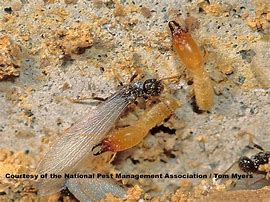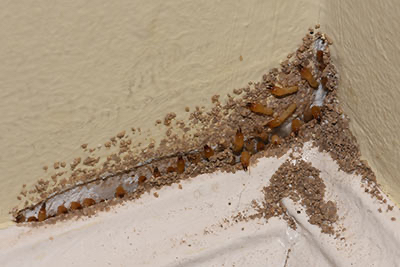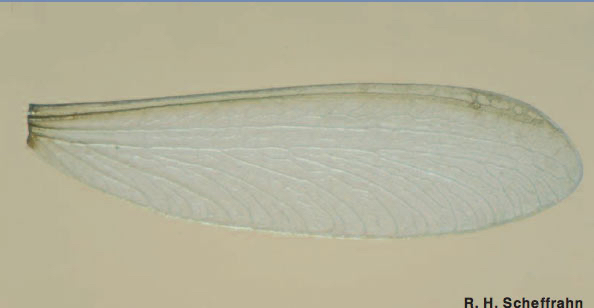Termites…A Primer on these Destructive Pests
Background
Recent estimates indicate that subterranean termites cause close to $5 billion worth of damage to structures in the U.S. Statistically, almost one in thirty U.S. homes has some level of termite infestation. Unfortunately, it can take ten years or more for the problem to become noticed; by then, substantial damage may have already been affected.

Regardless of how well woodwork is built or maintained, once wood-destroying insects like beetles, termites, and carpenter ants find their way into the wood, they can wreak havoc. These insects are more than a nuisance; they are dangerous and can cause significant, costly damage. What’s worse, they can cost a small fortune to treat and eradicate.
Do not be fooled into false confidence that concrete and steel-beam construction of your home makes you immune to termites! What about the wood construction elements in your home? These wood-gnawing pests attack decks, door frames, and railings. But what are there entranceways? Often, termites will hitchhike inside wood products like antique furniture, bed frames, nightstands and desks, many times originating from overseas. Going antiquing or to a yard sale this weekend? Be careful because you may bring home more than you ‘bargained’ for.
Remember that in all likelihood, you don’t see these pests until the damage is being done. Damage to wood by termites happens during their feeding; they create tunnels and nests within the wood (food) source. Do they leave any telltale signs of activity you can detect? Frequently these wood destroying insects leave pinholes on the surface or a little pile of sawdust indicating their chewing and tunneling has taken place.
Frequency and Species
Termites are the most economically important wood-destroying insects and are found throughout the country aside from Alaska. There are generally three types of termites: subterranean, drywood and dampwood, with the subterranean form being the most common and costly. Typically, the adults and juvenile forms cause the greatest destruction to wood-based structures and furniture.

Throughout the US, termite issues increase in severity as temperatures rise and when increased rainfall is most common; typically, early to mid-spring. Inspection is key to early detection, especially lower floors or areas in buildings or homes. If a section of wood breaks off easily or feels spongy, termites are likely the cause.
Don’t be fooled into thinking that termites simply crawl; be vigilant during early spring or late fall for flying ant-like insects that are generally termed ‘swarmers’. You may actually see a pile of wings under a window sill or door jamb. Common evidence of termite activity and a definite sign to call Millette Pest Control.

What Can a Homeowner Do to Prevent Termites?
While complete prevention is not possible, there are ways you as a homeowner can make your environment less friendly or conducive for these strong-jawed insects.
Please consider a few ideas offered by the National Pest Management Association:
- Keep basements, attics and crawl spaces well-ventilated and dry
- Repair leaking faucets, water pipes and A/C units on the outside of the home or building
- Repair fascia, soffits and rotted roof shingles promptly and properly
- Replace weather stripping and repair loose mortar around basement foundations and windows
- Direct water away from your home or building through properly functioning downspouts, gutters and splash blocks
Remember, termites are attracted to moisture so inspect the perimeter of your home in both the spring and fall, making certain that you have good drainage that leads away from the perimeter of the foundation. Try to keep lumber and firewood off of the soil and away from touching your home; these are tasty treats for these voracious wood feeders. Mulch is another favorite of termites, so try to keep it away from the outer walls of the building. And if your garage is a separate standing structure, don’t forget it too must be protected by inspection and these few easy to implement steps.
And if you suspect you have termite activity, call us for an appointment to discuss the options available for effective treatment and long-term control/maintenance. You can always snap a few pictures of the area of concern or the mud tunnel and or insect and send it to us via text at 860-274-9503 or e mail us at Mpc@millettepestcontrol.com as well. If possible, save the insect sample or wings for us to look at when we come to inspect.
If it has been confirmed, you have termites …Now What to Do?
Your home is likely the most expensive purchase you will ever make. Termite destruction can ruin this investment. You need to ACT to prevent this from happening.
There are two basic directions you can consider when termites have been discovered on your property and it requires treatment. You can choose between a termite baiting system such as Sentricon® or a liquid ground termite treatment with a termiticide (e.g., Termidor® SC). Termite baiting systems are now installed active and ready for Termites to find and then pass this active ingredient throughout the colony, resulting in eventual colony collapse. Recognize that stations need to be monitored annually after the initial installation. The above ground station If used inside on an active termite tunnel will need to be checked monthly at first then once the feeding activity has stopped it can be removed. An annual inspection and renewal is required to maintain termite coverage.
Although the use of a termite bait station system requires regular annual monitoring and replacement of certain parts or bait , baiting systems do have certain advantages. Bait stations use very little active ingredient, which is protected in tamper-resistant stations. This makes baiting the preferred approach in situations where there may be a risk of water contamination. For example, with homes in low elevation areas such as those commonly found near bodies of water like oceans, lakes, or rivers. Installation of bait stations does not disturb the foundation of a structure. Bait stations are often the preferred choice over the use of an alternative method (e.g., liquid termiticide treatment), which requires trenching. Homes or structures that are located on or around rock beds and that have concrete slabs adjoining the foundation make baiting systems far easier to install. For those homeowners that express primary concerns about environmental safety and chemical sensitivity around the structure, termite bait stations are often the preferred choice.
A quick comparison between a baiting system approach and liquid treatment strategy demonstrates other advantages:
- Scientific studies document colony elimination is far superior
- Elimination of the termite queen most often
- Treatment is minimally-to-non-disruptive to home, lawn and landscaping
- Treatment effectiveness does not degrade over time
- No label restrictions around water sources and wells
- Treatment is removable
Although highlighted above are many of the advantages in considering use of a termite baiting system, let’s review the features of a liquid ground treatment.
- A liquid treatment forms a continuous barrier protecting the structure, in contrast to the discontinuous barrier in baiting systems that have gaps between the placement of the stations.
- Barrier liquid treatment is more labor-intensive initially, and while there is no cost of upkeep or replacement parts such as that associated with bait station systems, a yearly inspection is required with any barrier method you choose. An Annual fee is required for inspection and renewal of termite coverage from year to year.
- A liquid termiticide approach often does not repel termites and spreads the active ingredient throughout the colony through contact and sharing food. Many liquid termiticides are undetectable by termites and interfere with basic functions such as grooming and feeding. Non-repellent termiticides, like Termidor, are reported to kill much more quickly than the active ingredient found in termite baiting systems, and treatments last in the ground longer.
The choice may seem daunting but that is why Millette Pest Control is here. We will explain the pros and cons of all approaches so that you can make the right decision for you!
